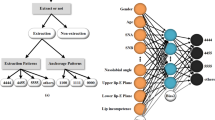Abstract
Objectives
Endodontic treatment works as a successful treatment modality in several cases. However, it may fail due to some reasons unforeseeable by the dentist. Many failures can be prevented by carefully assessing the difficulty level of the case before initiating treatment or by referral to a specialist. This study presents an approach using machine learning to generate an algorithm which can help predict the difficulty level of the case and decide about a referral, with the help of the standard American Association of Endodontists (AAE) Endodontic Case Difficulty Assessment Form.
Materials and methods
Using the AAE Endodontic Case Difficulty Form after obtaining the patients’ consent, 500 potential root canal patients were diagnosed. The filled forms were assessed by two pre-calibrated endodontists, and, in cases of conflicting opinion, a third endodontist’s opinion was taken. Artificial neural network was used for generating the algorithm.
Results
Using 500 filled AAE forms, a sensitivity of 94.96% was achieved by the machine learning algorithm.
Conclusion
This study provides an option for automation to the conventional method of predicting the difficulty level of a case, thus increasing the speed of decision-making and referrals if necessary.
Clinical relevance
An AAE Endodontic Case Difficulty Assessment Form when utilized along with machine learning can assist general dentists in rapid assessment of the case difficulty. This is a helpful tool in developing countries, where endodontic treatment and referral guidelines are often neglected. It also helps to make difficulty level assessments easier for novice practitioners, when they are in doubt about the same.


Similar content being viewed by others
References
Reiser SJ, Reiser SJ. (1981) Medicine and the reign of technology. Cambridge University Press
Foster KR, Koprowski R, Skufca JD (2014) Machine learning, medical diagnosis, and biomedical engineering research-commentary. Biomed Eng 13(1):94. https://doi.org/10.1186/1475-925X-13-94
Carrotte P (2004) Endodontics: part 2 diagnosis and treatment planning. Br Dent J 197(5):231. https://doi.org/10.1038/sj.bdj.4811612
https://www.aae.org/specialty/wp-content/uploads/sites/2/2017/06/2006casedifficultyassessmentformb_edited2010.pdf . Accessed on 8 February 2019
Jiang F, Jiang Y, Zhi H, Dong Y, Li H, Ma S (2017) Artificial intelligence in healthcare: past, present and future. Stroke Vasc Neurol 2:230–243. https://doi.org/10.1136/svn-2017-000101
Han J, Pei J, Kamber M (2011) Data mining: concepts and techniques. Elsevier
Kim EY, Lim KO, Rhee HS (2009) Predictive modeling of dental pain using neural network. Stud Health Technol Inform 146:745–746
Käkilehto T, Salo S, Larmas M (2009) Data mining of clinical oral health documents for analysis of the longevity of different restorative materials in Finland. Int J Med Inform 78(12):e68–e74. https://doi.org/10.1016/j.ijmedinf.2009.04.004
Korhonen M, Gundagar M, Suni J, Salo S, Larmas M (2009) A practice-based study of the variation of diagnostics of dental caries in new and old patients of different ages. Caries Res 43(5):339–344. https://doi.org/10.1159/000231570
https://firebase.google.com/. Assessed on 25/09/2018
Deng N, Tian Y, Zhang C (2012) Support vector machines: optimization based theory, algorithms, and extensions. Chapman and Hall/CRC
Goodfellow I, Bengio Y, Courville A, Bengio Y (2016) Deep learning. MIT press, Cambridge
Duchi J, Hazan E, Singer Y (2011) Adaptive subgradient methods for online learning and stochastic optimization. J Mach Learn Res 12:2121–2159
Swartz DB, Skidmore AE, Griffin JA (1983) Twenty years of endodontic success and failure. J Endod 9(5):198–202. https://doi.org/10.1016/S0099-2399(83)80092-2
Chandra BS, Gopikrishna V (2014) ENDODONTIC PRACTICE. Wolters Kluwer India
https://www.aae.org/specialty/wp-content/uploads/sites/2/2017/06/educatorguidetocdaf.pdf. Accessed on 7/7/19
Ingle JI, Bakland LK, Baumgartner JC (eds) (2008). Ingle's endodontics 6. PMPH USA
Acknowledgments
We thank all the participants of this study.
Author information
Authors and Affiliations
Corresponding author
Ethics declarations
Conflict of interest
The authors declare that they have no conflict of interest.
Ethical approval
The study has been approved by the appropriate Ethics Committee (Nair Hospital Dental College; Mumbai, India approval no. EC-84/CONS-09ND/2018). All procedures performed in studies involving human participants were in accordance with the ethical standards of the institutional and/or national research committee and with the 1964 Declaration of Helsinki and its later amendments or comparable ethical standards. All procedures performed in studies involving human participants were in accordance with the ethical standards of the institutional and/or national research committee and with the 1964 Helsinki declaration and its later amendments or comparable ethical standards.
Informed consent
Informed consent was obtained from all individual participants included in the study.
Additional information
Publisher’s note
Springer Nature remains neutral with regard to jurisdictional claims in published maps and institutional affiliations.
Rights and permissions
About this article
Cite this article
Mallishery, S., Chhatpar, P., Banga, K.S. et al. The precision of case difficulty and referral decisions: an innovative automated approach. Clin Oral Invest 24, 1909–1915 (2020). https://doi.org/10.1007/s00784-019-03050-4
Received:
Accepted:
Published:
Issue Date:
DOI: https://doi.org/10.1007/s00784-019-03050-4




